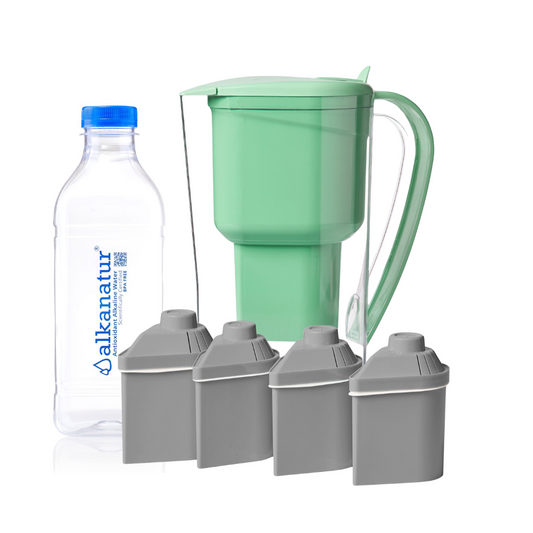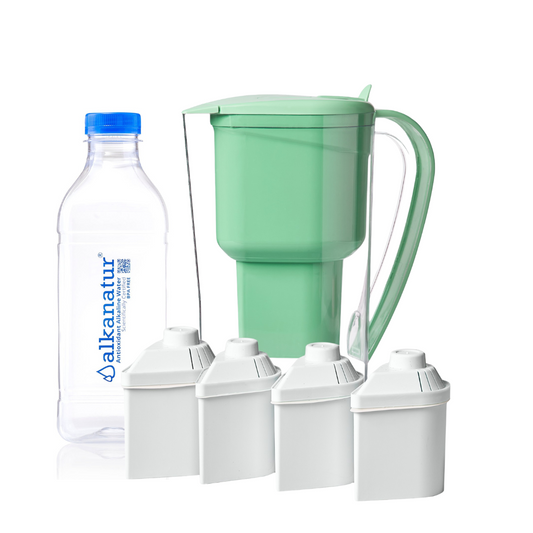Alkanatur proves through research made by the University of Vigo...
...that the water coming from our pitcher Alkanatur Drops, reduces the oxidative stress and the levels of triglycerides
In the line of research that Alkanatur maintains with some Universities, we've received from the University of Vigo the results of an unprecedented study worldwide about oxidative stress in a so serious pathology as type 1 diabetes. This preclinical study was carried out in the modern University facilities of the CITI.
The report we show is a summary extracted from this Study. It is focused to the general public.
First of all, do you know what oxidative stress is?
It is known that from a certain age, we have oxidative stress, that is, the increase of external oxidants and the decrease of internal antioxidants. Depending on the imbalance of this, we age much faster besides contracting many more diseases.
The entire scientific community worldwide support this fact, and that is why our first scientific research deals with oxidative stress and how to fight it by adding antioxidants.
The catalase concentration and lipid peroxidation are the scientific values that are used worldwide for measuring oxidative stress.
Alkanatur Research
The graphs provided are a clearer reference of the results of this Study.
The ph of the alkaline water, during the 2 months of the treatment, oscillated between 9.5 and 9.8. This same parameter was between 5.9 and 6.4 in the water from the public supply

It is important to stand out that the consumption of alkaline water during 2 months have shown a significant decrease in blood triglyceride levels.
TRIGLYCERIDES IN BLOOD

Concentration of blood triglycerides during one month and two months of alkaline water treatment
The second parameter with an oscillation is the level of catalase in blood:
Type 1 diabetes is a disease that initially affects the pancreas, stopping completely the insulin secretion. The rest of the organs are affected after a period of time, our research only lasted two months, and liver and kidney need more time to throw values.
CATALASA IN PANCREAS

Levels of catalase in pancreas treated with alkaline water during one and two months
“The intake of alkaline water during 2 months has led to a significant decrease in the concentration of catalase in the pancreas”.
The intake of alkaline water induces a decrease in the concentration of this enzyme in the pancreas, which suggests that alkaline water makes decrease the pancreatic oxidative stress.
The third of the positive results at the pancreatic levels is the TBARS analysis:
The decrease in the degree of pancreatic lipid peroxidation while drinking alkaline water during 2 months.
TBARS PANCREAS

Degree of lipid peroxidation (expressed in nanomoles of malonaldehyde acid per grams of cellular tissue)
CONCLUSIONS:
Our perspective of this research from the integrative medicine:
The own professor who directed this Study, was really skeptical about the results at the beginning of the investigation, because she didn’t know before any publication made with ionized alkaline water, in a so serious pathology as type 1 diabetes.
In the words of the Professor Lafuente: “The effect of Alkanatur Drops water on the parameters related to oxidative stress (catalase concentration and degree of lipid peroxidation) in the pancreas, the organ damaged in the pathology type 1 diabetes, is awesome. Congratulations for this results”
We decided to start with this pathology because we knew that the pancreas would suffer a big oxidative damage, later we will perform other researches in different diseases and measuring different parameters.
Integrative medicine does not distinguish the type of pathology. According to the perspective of a wide scientific community, behind the diseases that affect us today, oxidative stress is either directly or indirectly as a pathological cause.
They all have something in common, the very high levels of acid free radicals that acidify and steal oxygen from the extracellular fluid in the affected area, and therefore the cell cannot be fed properly and it is also exposed to its own metabolic detritus (waste elements), that make the cell full of toxicity, over time that situation is spread to the rest of the body originating new pathologies.
World renown Scientists and Doctors are following these guidelines that other colleagues like Dr. Otto Warbung (Medicine Nobel Prize) and the recently deceased Professor of Histology at the University of Vienna Dr. Alfred Pischinger had previously started.
“Sistematic Researches in the last 50 years has led to the development about free radicals in the biological and biomedical sciences.
The field of knowledge is consolidated.
In the International databases from the period of the 2000 to the 2004 the entry “free radicals” indicates 27200 scientific works. The entry “radical superoxide and hydrogen peroxide appears with 10900 scientific works. The entry “peroxides and peroxidase” refers to 15000 scientific works and the entry “nitric oxide” indicates 27600 scientific works.
However the practical applications of the use of antioxidants and other drugs, that lead to preventive and adjuvant pharmacological therapies that are effective, are a chapter in development process.
Special thanks:
Anunciación Lafuente Giménez: PhD in Biology, Professor of Toxicology at the University of Vigo.









